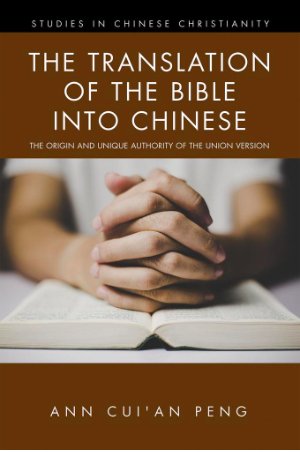Ann Cui’an Peng, The Translation of the Bible into Chinese, a volume in the series Studies in Chinese Christianity, co-edited by Carol Lee Hamrin and G. Wright Doyle. Eugene, OR: Pickwick Publications, 2021.
This book represents a milestone in the history of the translation of the Bible into Chinese. Building on earlier research, it fills in some gaps and provides us with a comprehensive account not only of the history of the Chinese Union Version (CUV), but also some of the reasons for its continued unique prominence as the Bible of choice for Chinese Christians around the world.
Disclosure: As co-editor of Studies in Chinese Christianity, the series in which this volume appears, I read several versions of the manuscript and provided editorial suggestions to the author.
I was originally planning simply to ask permission to reprint the outstanding review published by ChinaSource in January of 2022 (ChinaSource | The Translation of the Bible into Chinese). Rather than trying to duplicate that article, I will attempt only to highlight a few features of Peng’s valuable work and refer you to the ChinaSource review for a more detailed description and evaluation.
Very briefly: Part I traces the history of Chinese Bible translation, from the “Nestorians” – now called the Church of the East – the Roman Catholic renderings, the early Protestant editions, and the Chinese Union Version. Part II shows how the Mandarin Version developed over the course of its translation, with a careful analysis of the principles that guided the translation, and then describes the most important revisions that have tried to bring that translation up to date.
In Part III, we learn why this version still has an unrivalled place in the hearts of Chinese Christians and in the life of Chinese churches around the world, as well as the major challenges that it faces now. This section “identifies the uniqueness of the UV as the most outstanding achievement of Western missionary Bible translation in Chinese and as a pioneer in the New Culture Movement, where it played a significant role in the reform of Chinese language and literature,” a fact of history highlighted also by Chloe Starr’s edited volume, Reading Christian Scriptures in China.
Dr. Peng, who is a Senior Associate of Global China Center, possesses unique qualifications to write this book. She is Chinese and a native speaker of Mandarin. She grew up in the Christian church, where the Union Version of the Bible was read and revered by all, and so she understands the peculiar position it holds in the minds and hearts of millions of Chinese Christians. She is an accomplished biblical scholar, trained in both Hebrew and Greek. Her scholarship was recognized by church authorities in China, who appointed her to a committee charged with a minor revision of the Union Version. Having earned her MA (1991) and PhD (2007) from the University of Birmingham, England, she writes elegant English. Despite Peng’s attention to detail and comprehensiveness, the book is a marvel of conciseness.
For many years, she served in the highest echelons of the state-sponsored Protestant body in China, both as a theological lecturer and vice-principal of the Nanjing Theological Seminary and as Director of the Commission on Bible Publication at the China Christian Council. She participated in Chinese Bible revision under the auspices of the United Bible Societies and was chief editor of the UV concise annotated version, published in 1998.
She balances a high regard for the work of Western missionaries who undertook to translate the Bible into Chinese with deliberate labor to give the Chinese translation assistants their due, recovering the names of some of them for Western readers for the first time. A table with their names in Chinese characters and Pinyin, along with the names of the missionaries with whom they worked, is especially valuable.
She also balances a tremendous respect and affection for the Union Version with a clear sense of its many imperfections. Like the missionaries who presented the Union Version to the world in 1919, she is keenly aware that it was always meant to be a provisional translation, waiting for the time when competent Chinese Christian scholars could produce a modern translation that was fully indigenous.
As a scholar, Peng displays a tenacious passion for precision and fairness, giving clear and equitable treatment of different positions on contentious issues, such as which style of Mandarin should be used and the proper translation of the Hebrew and Greek words/names for God. She interacts with recent scholars, both Western and Chinese, who have written on the history of the Union Version and the criticisms of it. Her treatment is the most up to date at this time. Despite its scholarly nature, the book reads easily.
The Translation of the Bible into Chinese is the product of a deep love for the Chinese Bible and immense personal sacrifice. During the last few years of revision and re-revision, she was battling advanced Parkinson’s Disease, even to the point of damaging her health in an attempt to submit the final manuscript in time for publication in 2019, the centenary of the publication of the Chinese Union Version. Repeated software glitches and mistakes by editors prevented her from meeting this self-imposed deadline, but she persisted anyway. We owe her a profound debt of gratitude.
The Translation of the Bible into Chinese will stand for years to come as an authoritative study of the history, translation process, and abiding authority of the Chinese Union Version.
G. Wright Doyle
